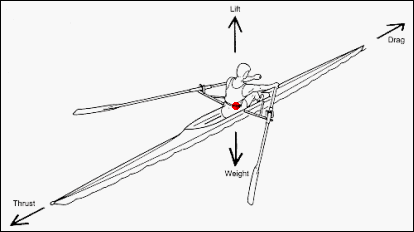| |
Similar
considerations apply to a single person boat illustrated by the diagram below.
The lift required to balance the downward force due to weight of the boat
and the oarsperson is provided by the displacement of water by the boat hull.
Lift
= -(mg).
If the boat is at rest in still air and water, these are the only forces
acting on the system.
To move the boat through the water, thrust
is provided by the complex interaction between the sculls and the water. Once
the boat is moving at a constant speed the thrust force will be opposed by
a drag force of equal magnitude and opposite direction: D = -(T). The drag will contain
three terms: hull friction drag, wave drag and aerodynamic drag due to the large
frontal area of the boat/operator system. The hull skin-friction drag increases
as the square of the boat speed with respect to the water, the wave drag
is kept as low as possible by giving the boat a long slender hull since the
hull-speed depends on the square root of the boat length, and aerodynamic drag
is minimized by using and aerodynamic design for the oarlocks and the operators
clothing. |
|
| |
|
From:
Abbott, Brooks and Wilson, "Human-Powered Watercraft," in "Human-Powered
Vehicles," Human Kinetics (1995) |
|
|
|
